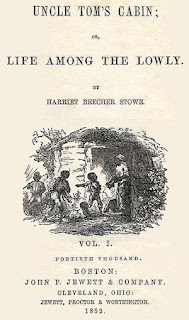Uncle Tom's Cabin

Uncle Tom's Cabin, by Harriet Beecher Stowe
I read this for my American history project, but I figure it counts as Victorian literature too!
Uncle Tom's Cabin was written as anti-slavery propaganda for white Northerners who, I suppose, didn't know much about the realities of slavery. It was a huge success and was very influential for the abolitionist cause, though now its Victorian sentimentality comes off as melodramatic and overdone. Uncle Tom, who was written as a Christ figure, has gotten something of an unfortunate reputation as a weak and servile character. (Yes, he's not very realistic, but neither is anyone else!) "Uncle Tom" became a stock character in minstrel shows, with little resemblance to Stowe's virtuous Christian protagonist.
As a novel, the characters are types and the whole thing comes off as unlikely. But accuracy wasn't the point anyway; she wanted to inflame feeling against slavery and so she succeeded at her task.
Interestingly, for much of the novel, slave owners are depicted as more virtuous than you might expect--certainly better than real slave narratives of the time showed. Nearly all of the slave owners are kind, well-meaning people; I suppose so that the targeted white readers would sympathize with them and not feel attacked, and so that Stowe could make one of her main points: no matter how kind an owner was, a slave could never feel safe. Those kind owners fall into debt, or hardship, or they get angry or they die, and then all the nice promises are meaningless if they aren't backed up with legal documentation. And anyhow, everyone would prefer freedom in poverty to slavery in comfort. So she wanted to really emphasize that even when slavery was used in an "ideal" way, as slave-owners often insisted was nearly always the case, it was still an awful system. I think she didn't want to give anyone a way to say "Well, if we just curb the abuses, it would work,"--she wanted to show that even the best possible case was hopelessly corrupt and wrong.
The book is full of unusually well-treated slaves brought up with educations by their owners (not usually their actual parents, for the separation of families is a major theme), who are then sold off to fates unknown. The plight of women is of particular concern; Stowe makes the girls' expected destinies very clear--though of course she never says anything outright. Her female characters are the ones who courageously figure out ways to run away from slavery and save their children, while Uncle Tom stays behind to bear the consequences. He could run, but he chooses not to in order to save others.
Uncle Tom's Cabin is really worth reading for the insight it provides into pre-Civil War America. I don't really think it's a work of great literature, but that wasn't what Stowe was trying to do. Reading it with its context and goal in mind is the way to do it. (Which puts me in mind of The Pilgrim's Progress, another popular classic that is classic because it was popular and hugely influential, not because it's a great literary work.)
For a realistic look at slavery, I would recommend the two classic autobiographical works Narrative of the Life of Frederick Douglass, an American Slave, and Incidents in the Life of a Slave Girl.





Comments
Post a Comment
I'd love to know what you think, so please comment!